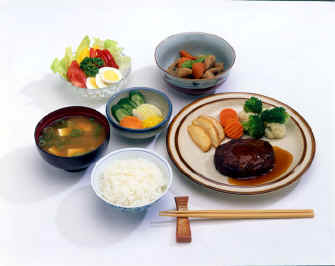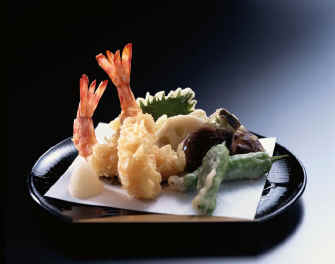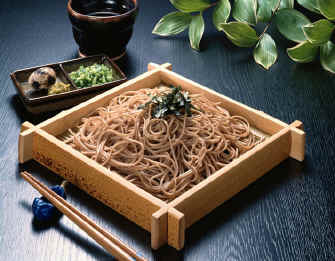Once known in the west either
in the form of "sukiyaki" or the more
exotic "sushi," Japanese cuisine has in
recent years become much more familiar and
appreciated around the world. Many visitors to
Japan will have already sampled the pleasures of raw
fish or batter-fried shrimp. But few first
time visitors to Japan are prepared for the variety
and sumptuousness of the food as it is traditionally
prepared. Eating in Japan is an experience to
be enjoyed and remembered fondly for the rest of
your life.
Among the types of cooking
found in Japan are:
Sukiyaki -
prepared right at the table by cooking thinly sliced
beef together with various vegetables, tofu and
vermicelli.
Tempura -
deep-fried food in vegetable oil, after being coated
with a mixture of egg, water and wheat flour.
Among the ingredients used are prawns, fish in
season and vegetables.
Sushi -
a small piece of raw seafood placed on a ball of
vinegared rice. the most common
ingredients are tuna, squid and prawn.
Cucumber, pickled radish and sweet egg omelette are
also served.
Sashimi -
sliced raw fish eaten with soy sauce.
Kaiseki Ryori -
regarded as the most exquisite culinary refinement
in Japan. The dishes are mainly composed of
vegetables and fish with seaweed and mushrooms as
the seasoning base and are characterized by their
refined savor.
Yakitori -
made up of small pieces of chicken meat, liver and
vegetables skewered on a bamboo stick and grilled
over hot coals.
Tonkatsu -
a deep-fried pork cutlet rolled in bread crumbs.
Shabu-shabu -
tender, thin slices of beef held by chop-sticks and
swished in a pot of boiling water, then dipped in a
sauce before being eaten.
Soba and
Udon - two kinds of Japanese noodles.
Soba is made from buckwheat flour and Udon from
dipped in a sauce, and are available in hundreds of
delicious variations.
Japanese "sake"
or rice wine, goes extremely well with a variety of
Japanese dishes. Brewed with rice and water,
sake has been a Japanese alcoholic beverage since
ancient times. Because it can be drunk warmed
up, the "feelings" come on more quickly
and in winter it warms the body. When drunk
chilled, good sake has a taste similar to
fine-quality wine. There are local sake
breweries in every region across the country, which
make their respective characteristic tastes based on
the quality of rice and water as well as differences
in brewing processes.
More
Information
on Japanese cuisine provided by the Japanese Embassy
|









